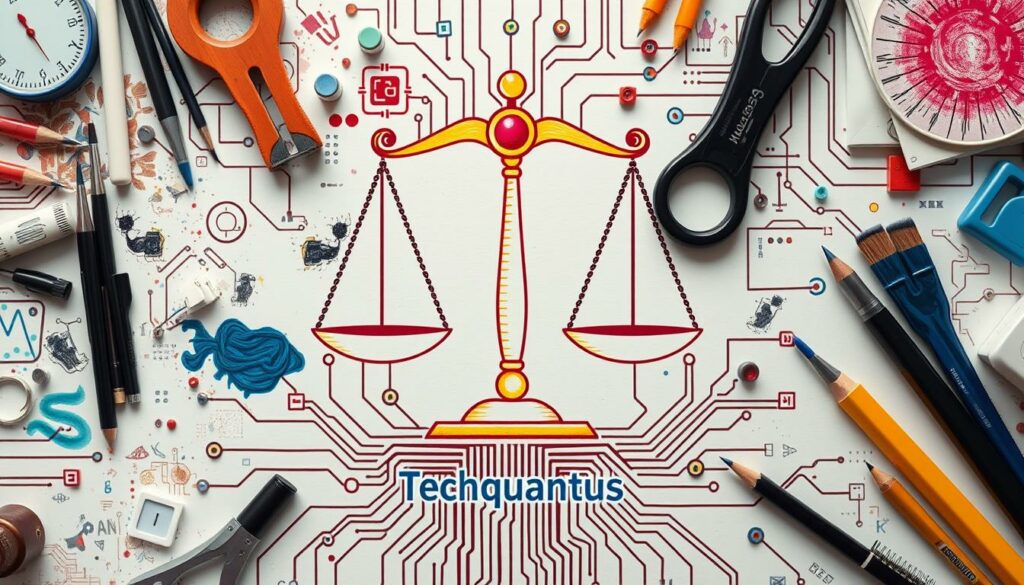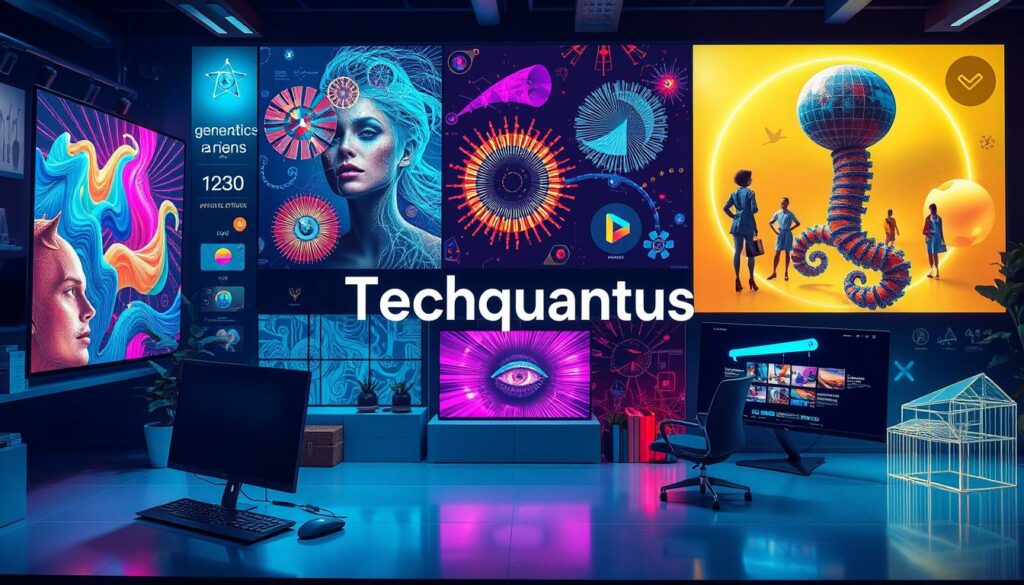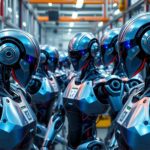Did you know generative AI could boost the global economy by up to 0.6 percentage points each year? This potential is changing the creative industries a lot. It’s making workflows faster and helping brands transform digitally. Generative AI automates content creation much faster than humans, giving more time for strategy and creativity.
The impact of AI on creative industries is huge. It makes tasks more efficient and boosts creativity with new ideas. As creative industries change, knowing how to use these technologies can give you an edge. It leads to better customer experiences and more personalized content.
Key Takeaways
- Generative AI boosts global productivity by automating content generation.
- It frees up time for strategic planning and enhances creative workflows.
- Generative AI tools streamline content creation, making them essential for marketing.
- AI analysis of customer behavior allows for personalized recommendations.
- Implementing generative AI can yield significant cost savings in creative projects.
Understanding Generative AI
Generative AI is a key part of artificial intelligence that makes new content by learning from old data. It uses machine learning to create unique things like text, images, and audio. This tech changes how many industries work, making art and creativity easier for more people.
Definition and Overview
Generative AI uses advanced machine learning to make new content. It looks at and combines information to create things that seem human-made. This helps make more creative work possible in fields where it’s very important.
It also makes creative tools available to more people, breaking down the usual barriers. This means more people can be creative, no matter their background.
The Technology Behind Generative AI
Generative AI relies on new tech in natural language processing and machine learning. Models like Generative Adversarial Networks (GANs), Variational Autoencoders (VAEs), and diffusion models are key. They help make sure the content is both new and good quality.
This tech is getting better all the time. It makes things more efficient and lets us explore more. But, it also brings up ethical issues, like where the content comes from and how it might be biased.
The Impact of Generative AI on Creative Industries
Generative AI is changing the game in creative fields, especially in how we make content and art. It brings automation to tasks that used to take a lot of time and effort. This makes things more efficient and opens up new ways to express art.
Revolutionizing Content Creation
Generative AI tools have really changed how we make content. Tools like Jasper and Runway help create content that really speaks to people, which gets more engagement. They help with writing, editing, and brainstorming, so creators can focus on the big ideas.
This is a big win for copywriting, as it makes writing text faster without losing quality. This means content can be made quicker and still be great.
Enhancing Visual Arts and Design
In visual arts, tools like DALL-E and Midjourney are pushing the limits of what’s possible. They use AI to make new art based on certain themes or ideas. For example, “Portrait of Edmond de Belamy” sold for $432,500, showing how valuable AI-generated art can be.
Generative AI also makes graphic design more efficient and creative. It lets designers try out many different ideas quickly. In advertising, it leads to new and creative ideas, showing how it’s changing the game in making visual identities.
| Application Area | AI Tools | Impact |
|---|---|---|
| Content Creation | Jasper, Runway | Enhanced speed and quality of text generation |
| Graphic Design | Midjourney, DALL-E | Increased design efficiency and variation |
| Advertising | Various integrated AI solutions | Innovative concepts and streamlined processes |
| Photography | AI-enhanced tools | Improved image refinement and workflow integration |
Generative AI is key to the growth of creative fields. It combines human creativity with tech to make new kinds of content and art. The future looks bright, offering new ways for creatives to explore and push boundaries.
Benefits of Generative AI in Creative Processes
Generative AI is a big help in making creativity better in many areas. It lets creative people work smarter, not harder. This means they have more time to think and come up with new ideas. Generative AI makes things more efficient and creative, changing how creative work is done.
Increased Efficiency and Productivity
Companies often struggle to keep up with their creative tasks. Generative AI makes things more efficient by doing the easy tasks automatically. This lets teams focus on the big projects. For example, tools like text-to-image can cut down the time it takes to come up with ideas. Companies can get 25% more done with generative AI.
Enhanced Creativity and Innovation
Generative AI sparks creativity by bringing new ideas and different views to the table. It helps people think outside the box. This makes innovation available to everyone, not just experts. With tools like DALL-E and GPT-4, artists and writers can work with AI to create something truly unique.
| Benefit | Impact on Creative Processes |
|---|---|
| Increased Efficiency | Automates repetitive tasks, allowing focus on strategic initiatives. |
| Enhanced Productivity | Estimates show a potential increase of 25% in creative output. |
| Fostered Creativity | Encourages diverse ideas and collaboration among all participants. |
| Democratization of Innovation | Enables broader access to creative tools for all skill levels. |
Generative AI, Creative Industries, AI Transformation
Generative AI is changing how industries work. It’s important to understand how it affects your creative work. These tools help people in music, art, and writing work better and think more creatively.
The Role of AI Transformation in Creative Workflows
Now, creative folks use AI tools like Midjourney, DALL·E 2, and Jasper.ai to make new content. This lets you try out many ideas and styles quickly. For instance, in architecture, tools like Autodesk’s Generative Design change how you design things.
Working with AI and humans together opens up new chances for creative projects. This makes your work better overall.
Transformations in Marketing and Advertising
Generative AI is changing marketing too. By 2025, it will make up 30% of big companies’ marketing messages. Brands that use this tech can get ahead in the digital world.
With generative AI, you can make content that really speaks to people. This makes marketing more effective. It’s important to update your marketing plans to use these new AI tools.
Generative AI is getting more powerful and is changing creative fields. Keeping up with these changes will help you use them to your advantage. To learn more about how generative AI is changing art, check out expert insights.
For more on how tech is impacting creative work, join TechQuantum. They talk about the big changes generative AI brings to creative work.
Combining Human Intelligence with AI
Using generative AI in creative work needs a balance between human smarts and machine power. Collaborative tools have changed how creatives work. They use human-AI teamwork, letting artists, writers, and designers boost their work while keeping their special touch.
Collaborative Tools for Creatives
There are many tools out there that make creative work easier. For example, Microsoft’s Copilot combines AI with Microsoft 365 apps to make writing, data modeling, and telling stories easier. These tools help you focus on the creative stuff and not the boring tasks. They can automate simple work, cutting down project times and making things more efficient.
Human-AI Synergy in the Creative Process
Mixing human creativity with AI ideas leads to new innovations. AI helps by coming up with original content and ideas for designs. But, it’s your artistic vision and gut feeling that add the final touch. This mix of science and art is key to making work that really speaks to people. Many case studies show how combining AI with human skills opens up new creative paths and changes what’s possible in art.
For more on how tech affects user privacy, check out Techquantum’s privacy policies. It shows why handling data responsibly is important as we explore more about working together with AI in creative fields.
Ethical Considerations of Generative AI
Generative AI is changing the creative world, bringing up important ethical questions. Artists and tech experts must deal with issues like intellectual property and data bias. They need to use this tech ethically to make the most of it.
Intellectual Property and Copyright Issues
Copyright issues are big when talking about generative AI. AI-made art can be hard to say who owns it. Since AI can make art that looks just like human-made art, who gets to claim it? Big names in the arts are looking into safe ways to train AI, like Getty Images with its AI image generator. They want to make sure they don’t break any copyright laws.
It’s important to have clear rules about who owns AI-made art. This is because AI uses copyrighted stuff to learn. We need to figure out how to handle these tricky ownership questions.
Data Bias and Fairness in AI Outputs
Data bias in AI is a big ethical problem. It can make AI prefer certain styles or views, leaving out others. Using diverse data in AI models is key to fair AI art. We also need to be open about how AI works and set ethical rules.
As humans and AI work together more, we’ll need to keep these ethical issues in mind. This way, we can make sure AI helps everyone, not just some.

| Issue | Description | Potential Solutions |
|---|---|---|
| Intellectual Property | Ownership disputes over AI-generated content | Develop clear copyright guidelines |
| Data Bias | Unintended preferences in AI outputs | Use diverse training data |
| Ethical Frameworks | Lack of ethical guidelines in AI usage | Establish industry-wide standards |
| Collaboration | Balancing human creativity with technical execution | Promote human-AI teamwork |
Challenges of Implementing Generative AI
Using generative AI in creative fields brings its own set of challenges. These implementation challenges come from the technical limitations of AI models. They also come from the need to balance automation with human creativity.
Technical Limitations and Performance Issues
Generative AI uses complex algorithms to create new content. But, it often faces reliability issues. Many models have trouble making high-quality outputs consistently, leading to unpredictable results.
These technical limitations hurt the performance of generative tools. They also make users hesitant to use them for work. Issues with bias in AI training data can make outputs not just wrong but also harmful. This raises ethical questions in creative fields.
Balancing Automation with Human Creativity
Automation can boost productivity, but it’s key to keep a balance with human creativity. Relying too much on generative AI can stop you from exploring new ideas. This can lead to less authentic and innovative work.
The best creative results come from using both technology and human insight. This means not letting AI take over. It’s about using AI tools wisely while valuing what humans bring to their work.
| Challenge | Description | Impact on Creativity |
|---|---|---|
| Technical Limitations | Reliability issues with AI-generated outputs | May lead to distrust in AI tools |
| Performance Issues | Inconsistent quality in creative outputs | Hinders creative flow and experimentation |
| Over-reliance on Automation | Potential stifling of authentic human expression | Reduces innovation and originality |
| Bias in Training Data | Risk of harmful representations in outputs | Challenges integrity of creative work |
Real-World Applications of Generative AI
Generative AI is changing the game in creative fields with new uses. By looking at case studies, we see how industries use this tech to boost their work and marketing plans.
Case Studies in Various Creative Fields
Many companies have made generative AI a key part of their work. For example:
- Golden State Warriors use AI in their Chase Center app to make fan experiences better during games.
- ING Bank created a generative AI chatbot to help customers more efficiently.
- BenchSci gives scientists tools to speed up biological research with generative AI.
- DaVita is using AI to improve kidney care and health services.
- HCA Healthcare launched Cati, a virtual AI assistant to help with care continuity.
Successful Implementations in Marketing Campaigns
Brands are using generative AI to make their marketing better. The big wins include:
- Amazon’s AI tool, Amazon Q, cut software update times, saving $260 million.
- US News saw big improvements in key metrics after using Vertex AI Search.
- Tokopedia sold 5% more unique products with Vertex AI.
- Large language models can change text, images, and sounds to make content for more people.
As generative AI grows, it’s making a bigger mark on creative fields. From marketing to various creative uses, examples show how businesses gain by exploring this new tech.

Future Trends of Generative AI in Creative Industries
The world of generative AI is changing fast, bringing new emerging technologies and fresh ideas. These changes will shape the future of creative fields. You’ll see more personal touches, better machine learning, and AI becoming a bigger part of business.
This will change how creativity is used in different areas. It’s an exciting time for the future of art and design.
Emerging Technologies and Innovations
Soon, generative AI will take over simple tasks, letting artists and designers dive deeper into their work. Skills in coding, data analysis, and creative thinking will be key. We’re already seeing this tech in music, fashion, and art.
This focus on creativity will lead to new ideas that make things faster and more tailored. Generative AI will show how it can save time and money in making content.
Predictions for the Next Decade
The market for generative AI is set to grow from $40 billion to $1.3 trillion by 2032. This growth will shift from infrastructure to software and services. With AI on the rise, new jobs will pop up for those skilled in these areas.
Working together with machines will open up new creative paths. Keeping up with future trends, ethical issues, and legal matters will be key. This ensures AI is used right in creative work.
| Industry | Expected Growth by 2032 | Key Benefits |
|---|---|---|
| Music Composition | Revenue expected to reach $280 billion | Enhanced creativity and speed in content creation |
| Fashion Design | Market for supporting services > $380 billion | Personalized customer engagement and cost efficiencies |
| Visual Art | Training infrastructure market $473 billion | Boosted innovation and ease of creation process |
How to Integrate Generative AI into Your Workflow
Adding generative AI to your creative work needs careful tool selection. It’s important to pick tools that fit your needs. Here are tips on finding the right tools and making them work for you.
Identifying Suitable AI Tools for Creative Work
First, look at the tasks in your projects where AI can help. Think about these points when choosing AI tools:
- Compatibility: Make sure the AI tools work well with your current setup.
- Functionality: Check if the tools can automate tasks that don’t need your team’s direct input.
- Innovation: Pick tools that help generate new ideas, like ChatGPT and Bard, which can open up new creative paths.
- Visualization: Look into tools like Midjourney and Dall-E for quick design concepts.
Steps for Successful Implementation
After picking the right AI tools, follow these steps for a smooth integration:
- Create a roadmap: Plan out each step of the integration process.
- Train your team: Teach your team how to use AI tools in creative tasks.
- Monitor progress: Keep an eye on how AI tools improve productivity and creativity.
- Iterate and refine: Use data to fine-tune your AI strategies for the best results.
- Prioritize data safety: Make sure your AI integration meets security and privacy standards.
With the right approach, generative AI can speed up project completion by up to 70%. By trying out and embracing AI tools, you can explore new creative ideas and find innovative solutions.
Conclusion
Generative AI is changing the way we think about art. It lets machines create art on their own using patterns and data. This is making art more innovative and opening up new ways to be creative.
Tools like generative adversarial networks (GANs) and AI for music are inspiring new ideas. They make art more engaging for the audience.
As digital transformation grows, using generative AI is key for growth and new ideas. Working with AI can make your art more exciting, telling stories in new ways, and giving people unique experiences. This mix of human creativity and AI leads to more experimentation and new possibilities in art.
The future of art is about working together and trying new things. Using generative AI can make your work better and attract more people. But, remember to think about the ethics of these new tools. This way, your art can be both new and responsible.
FAQ
What is generative AI?
Generative AI is a type of artificial intelligence that creates new content. It uses machine learning and natural language processing to make content that seems human-made. This technology can create many types of content.
How is generative AI impacting the creative industries?
Generative AI is changing how creative work gets done. It automates tasks like writing and editing. This lets creators focus more on strategy and innovation, making their work better.
What are the benefits of using generative AI in my creative processes?
Using generative AI can make your creative work more efficient and productive. It automates boring tasks, letting your team focus on new ideas. This can greatly improve your work and help the global economy.
What ethical considerations should I be aware of when implementing generative AI?
You should think about intellectual property and data bias in AI outputs. Making sure AI content is fair and represents everyone is key to ethical use in the creative field.
Can generative AI work alongside human creativity?
Yes, generative AI and human creativity work well together. AI can start with ideas, but humans need to refine them. This mix leads to more innovative and effective creative work.
What challenges might I face when adopting generative AI?
You might face issues like AI output reliability and finding the right balance between automation and human creativity. It’s important not to rely too much on AI to keep your work original.
What are some real-world applications of generative AI in creative fields?
Generative AI is used in writing, visual arts, and marketing. Brands use it to engage customers and get great results. There are many examples of how AI has helped in these areas.
How can I integrate generative AI into my existing workflows?
Start by picking the right AI tools for your creative tasks. Then, follow steps like assessing tools, checking results, and improving your approach over time.
What trends should I watch for regarding the future of generative AI in creative industries?
Look out for new technologies like more personalization and better machine learning. Experts believe generative AI will change creative work a lot in the next decade.
Source Links
- How Generative Artificial Intelligence is Changing Creative Work
- Generative AI transformative applications | KAIZEN™ Article
- Explore How Generative AI is Transforming Creative Industries
- Understanding Generative AI: The Future of Creative Artificial Intelligence
- Explore How Generative AI Transforms Creative Industries
- The Future of Creativity: How Generative AI is Revolutionizing Art and Design | #art #generativeai…
- The Impact of Generative AI on Creative Professions
- Generative AI in the US Creative Industries: Trends and Impacts
- How Generative AI Can Augment Human Creativity
- The Role of Generative AI in Creative Industries – Revolutionizing Art, Music, and Content Creation
- How Generative AI Can Augment Human Creativity – Insights
- Transformation of Creative Industries with Generative AI
- Impact Of Generative AI On Creative Work In 2023
- Replacement of human artists by AI systems in creative industries
- Combining AI and Human Intelligence: Adding Value in the Age of Automation and AI
- Unveiling the Magic of Generative AI: Where Technology Meets Human Creativity
- Implementing AI with Process & Human Intelligence
- AI and the Future of Art: Ethical Considerations for Creativity
- Generative AI: copyright, ethics and transparency issues for artists
- The Future of Creative Industries with Generative AI
- AI and the Creative Industry: A Paradox of Disruption and Empowerment
- Generative AI: Challenges, Risks and Opportunities
- Top 100+ Generative AI Applications / Use Cases in 2024
- 101 real-world gen AI use cases from the world’s leading organizations
- The Rise of Generative AI: Exploring the Future of Creative Careers
- AI and the Future of the Creative Industries – NAB Amplify
- How to Use AI in Creative Workflows (Tips & Examples) | Superside
- Get Your Business Ready For GenAI | Rōnin Consulting
- Generative AI in Creative Industries: Transforming Art and Innovation
- How Generative AI is Transforming Creative Industries
- How Generative AI Revolutionizes Creative Industries: Changing Art, Music, and Design
- My Guide to Understanding Data Centre Architecture: Core Components Every IT Pro Should Know
- Wazuh Home Network Setup: A Step-by-Step Guide
- Quantum Computers Decrypting Blockchain: The Risks and Implications
- Wazuh: Enterprise-Grade Security for Your Business
- Wazuh for Beginners: A Comprehensive Guide
Related posts:
 AI in Cybersecurity: The New Frontier in Protecting Data
AI in Cybersecurity: The New Frontier in Protecting Data
 Big Data Meets AI: Transforming Business Decision-Making
Big Data Meets AI: Transforming Business Decision-Making
 Natural Language Processing: How AI Understands and Responds to Us
Natural Language Processing: How AI Understands and Responds to Us
 Ethical AI: Balancing Innovation and Responsibility
Ethical AI: Balancing Innovation and Responsibility
 AI-Powered Robots: The Next Step in Automation
AI-Powered Robots: The Next Step in Automation
 Artificial Intelligence in IT Operations (AIOps): What’s Next?
Artificial Intelligence in IT Operations (AIOps): What’s Next?
